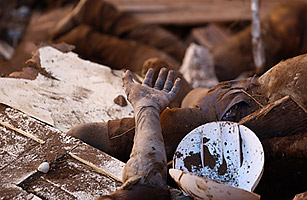
The corpses of earthquake victims lie in a mass grave on the outskirts of Port-au-Prince, Haiti
I know from hideous memory that you smell a mass grave long before you see it, so the stench of death filling our car tells me we're getting close. Up on the hillside, I see the machines of this macabre industry: a bulldozer, a backhoe and a dump truck. As we drive up, my driver points to freshly dug trenches — long gashes in the earth awaiting a new consignment of corpses. The dump truck is poised over one of these, and three men, their faces obscured by masks to keep out the odor, are tipping bodies into the ditch. As they fall, arms flail, heads snap back and forth and flesh scrapes against gravel, making a sawing sound.
It is 13 days after the Jan. 12 quake. We're an hour's drive northeast of Port-au-Prince, just short of the village of Titanyen. This is where Haiti's horrors, past and present, intersect.
The trenches in the earth are for the tens of thousands who were killed; the government has said that more than 150,000 people have already been interred in mass graves like the ones in Titanyen. But it was also in Titanyen where, during the three-decade tyranny of "Papa Doc" and "Baby Doc" Duvalier, government thugs brought political rivals, executed them and buried their bodies, often in unmarked graves. Locals say hundreds, possibly thousands, were killed this way in the 1960s, '70s and '80s, and throughout Haiti, the very name Titanyen has a diabolical reputation.
But precisely for that reason, finding the grave site is no easy task. We had driven into the village and stopped at the open-air market to ask for directions. But the mention of mass graves made the villagers uncomfortable, even angry. "We don't want to talk about it," they said. "It's a bad place, a blighted place." One woman, a mango seller, upbraided my translator, Earnest, for trying to take an "innocent foreigner" (her words) to such a place. People walked away from us, refusing even to give us their names.
The reluctance to talk about the graves is rooted, at least in part, in the voodoo belief that the souls of people buried without the correct rituals remain close at hand and sometimes put a hex on the area. Some followers of voodoo believe that Haiti is cursed by the souls of the thousands of people who were killed and improperly interred by the Duvaliers. Later in the day, back in Port-au-Prince, a voodoo "mambo" (or priestess) called Margo would describe Titanyen as "the place of angry souls."
So it takes a great deal of cajoling from Earnest before the mango seller tells us to drive back up the highway, past a small beach. The stench guides us the rest of the way.
Burying tens of thousands of people is a job for people with a stout heart and cast-iron stomach. The woman operating the bulldozer, who gives us only her first name, Edith, has both. "It has to be done," she says, arching her eyebrows and closing her eyes at the same time. The men on the Dumpster wave us away when we approach, but I see that one of them has vomit stains running down his shirt and trousers.
After the crew members have completed their grisly duty and driven back to the city, I notice that a short distance from the graves, other trucks have dumped mounds of rubble. Some men from the village have gathered there to scavenge — mainly for twisted rebar, to sell as scrap. One of them tells us (we've been joined by a couple of photojournalists) to go around the hill. There were bodies left in the open, he says.
He is right. Out of sight from the main road, some dump trucks seem to have simply unloaded their cargo of corpses and rubble into the open. Some halfhearted attempts at burial have been left incomplete. The result is a scene from a bad horror film: mounds of red earth, with body parts sticking out at grotesque angles. Some bodies are totally exposed, putrefying into a shade of yellow I've never seen. Millions of flies fill the air with a collective hum of a small generator.
Out of instinct, I get out my camera and take pictures. I usually do this when I'm on assignment, to show friends and family where I've been and to jog my memory in years to come. But after a few shots, I wonder, Why bother? It's not like I'm ever going to show these pictures to anybody. And I don't need them for myself, because they will remain forever in my nightmares. Titanyen's curse is now mine too.
Read more in the new TIME book Earthquake Haiti: Tragedy and Hope and support TIME's Haiti relief efforts.